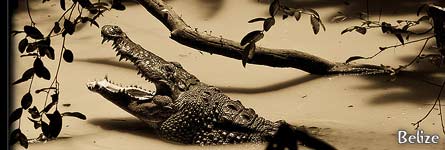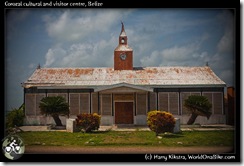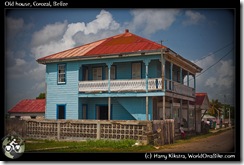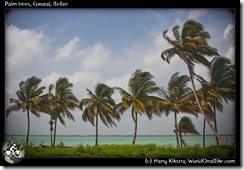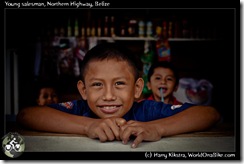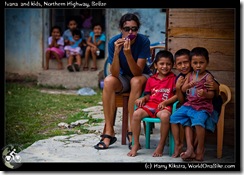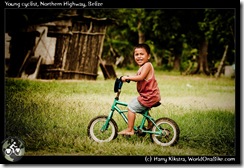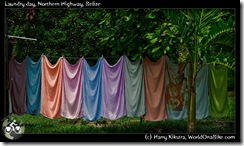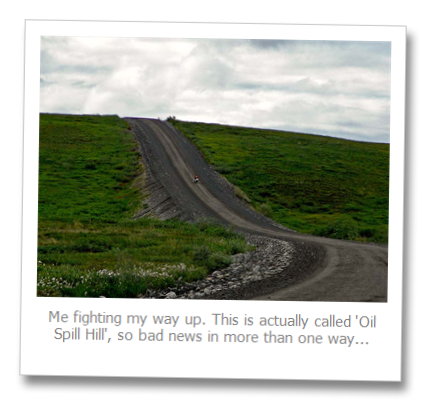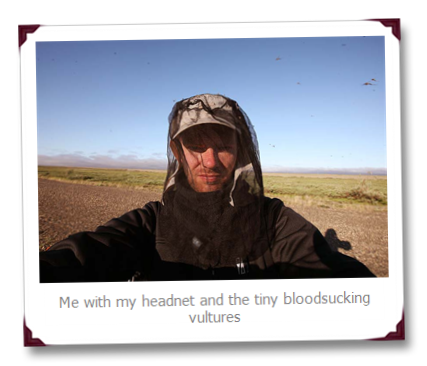Day 380-383, 26-29 July: The Northern Highway and shady Belize City, into Belize!
October 28, 2009 by Harry
Filed under Trip reports, Central America, Belize
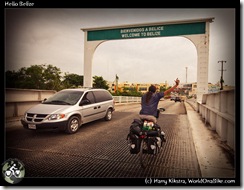 After crossing the bridge that separated Mexico from Belize, we still had to do some formalities. I could just ride my bike into the office and get a free stamp, valid for 4 weeks, but Ivana had to pay.
After crossing the bridge that separated Mexico from Belize, we still had to do some formalities. I could just ride my bike into the office and get a free stamp, valid for 4 weeks, but Ivana had to pay.
Sometimes being an Argentine helps dodging costs: for some unknown reason she does not have to pay for visa for for example turkey & India, whereas I do. But in order to enter Belize, she needed to pay B$100, 100 Belize Dollars, equalling USD $50! It must have something to do with the old ties to the Argentine archenemies, the Brits (Islas Malvinas, anyone?).
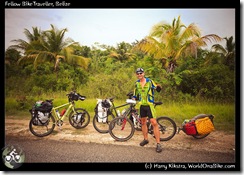 We also had to state where we wanted to exit Belize, which we had not expected. As there are only 3 options and we did not want to exit the way we just came in, we had to choose between the land border close to Tikal, Guatemala and the Southern sea-port of Punta Gorda. We opted for the latter and so the basics of our time and route through Belize were fixed more than we would have liked to: maximum 4 weeks, in through the North, out through the South.
We also had to state where we wanted to exit Belize, which we had not expected. As there are only 3 options and we did not want to exit the way we just came in, we had to choose between the land border close to Tikal, Guatemala and the Southern sea-port of Punta Gorda. We opted for the latter and so the basics of our time and route through Belize were fixed more than we would have liked to: maximum 4 weeks, in through the North, out through the South.
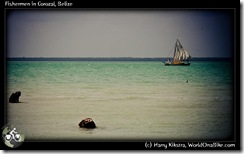 We continued on a flat road through muggy mosquito-filled fields and even met another cyclist headed North, who showed us his bike with mono-wheel trailer. he said it was very strong, but while demonstrating how to get on the bike, it came off, which did not seem too secure to us..
We continued on a flat road through muggy mosquito-filled fields and even met another cyclist headed North, who showed us his bike with mono-wheel trailer. he said it was very strong, but while demonstrating how to get on the bike, it came off, which did not seem too secure to us..
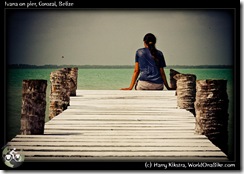 Some miles later, we rolled through neatly trimmed lawns –seems the Brits left another legacy here- topped with old and worn houses into the fisherman’s town of Corozal. We liked the relaxed and friendly place, enjoyed some nice hand-made ice-cream and went to look for a cheap place to stay.
Some miles later, we rolled through neatly trimmed lawns –seems the Brits left another legacy here- topped with old and worn houses into the fisherman’s town of Corozal. We liked the relaxed and friendly place, enjoyed some nice hand-made ice-cream and went to look for a cheap place to stay.
The cheapest rooms were in this non-touristic town where still more than B$25, which was more than our daily budget. We started to believe the scary stories of costly Belize that other travellers had told us.
 Finally we came upon a nice classic-looking hotel, named the sea-breeze hotel. We asked owner Gwynn if we could camp in his yard but he insisted we camp within the gate and under shelter of his sea-view bar instead. A while later he even offered us to stay for free in the spare room that was normally used by the cook, thanks Gwynn!
Finally we came upon a nice classic-looking hotel, named the sea-breeze hotel. We asked owner Gwynn if we could camp in his yard but he insisted we camp within the gate and under shelter of his sea-view bar instead. A while later he even offered us to stay for free in the spare room that was normally used by the cook, thanks Gwynn!
Later it turned out that it was not only the most economical place in town (B$40 or USD $20 for a room which could fit 3 or even 4 persons), but also most recommended by Lonely Planet and we planned to come back later with my sister.
Some more pix of Corozal:
Day 381: 27th July 2009, Corozal – Carmelita, 60km
 There are only 3 real roads in Belize, aptly named: The Northern Highway, The Western Highway and the southern Highway, all ending/starting in centrally located Belize City. Even so, there was almost no traffic on the Northern Highway that we were on, and we followed the gentle lines of the landscape without much bother of diesel-powered machines.
There are only 3 real roads in Belize, aptly named: The Northern Highway, The Western Highway and the southern Highway, all ending/starting in centrally located Belize City. Even so, there was almost no traffic on the Northern Highway that we were on, and we followed the gentle lines of the landscape without much bother of diesel-powered machines.
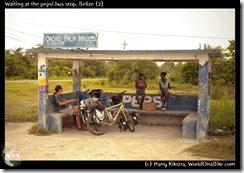 It was becoming a bit of a game to guess what language the people spoke and understood.
It was becoming a bit of a game to guess what language the people spoke and understood.
Though the official language is English, a large part of the population (the Maya) still only speaks Spanish and the ones that do speak English (mostly the dark-skinned Creole and Garifuni population) have their own pidgin variation of it, which would pass no teacher’s test.
 Then there are the Mennonites, who speak their own tongue (with elements of German as well as Dutch) and are important part of the population as they create about 45% of the nation’s food supply; dressed as if they were starring in the video clip of Weird Al’s Amish Paradise or stepping out of a 16th Century Dutch master’s painting.
Then there are the Mennonites, who speak their own tongue (with elements of German as well as Dutch) and are important part of the population as they create about 45% of the nation’s food supply; dressed as if they were starring in the video clip of Weird Al’s Amish Paradise or stepping out of a 16th Century Dutch master’s painting.
We found that bananas were still affordable here (8 for a B$) and discovered a new treat: ideals. Frozen bags of hyper-sweet lemonade in different flavours, well worth the 25cts the small shops charged.
Some Mayan kids at the ideal shop, enjoying their own goods as much as we did:
Belize hospitality
 We passed around the larger city of Orange Walk and ended our day in a small town of Carmelita. The shops and restaurants were closed, save one, but the 2 dark-skinned guys were so unfriendly that we rather went hungry than giving them business. When asking for a place to camp, a nice young guy named Junior insisted we would join him to his family’s house, and thus we went.
We passed around the larger city of Orange Walk and ended our day in a small town of Carmelita. The shops and restaurants were closed, save one, but the 2 dark-skinned guys were so unfriendly that we rather went hungry than giving them business. When asking for a place to camp, a nice young guy named Junior insisted we would join him to his family’s house, and thus we went.
We cooked our emergency spaghettis and pitched our tent inside a small building next to their home, to ward off the hordes of mosquitoes. The night was incredibly hot and we did not sleep much. Outside one of the poor dogs was doing a constant and sad ‘silly walk’ as a result of a wrongfully executed injection.
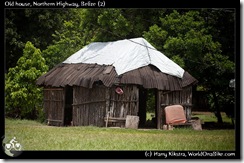 The chip-sealed road did not change much all the way into Belize City. We passed some small towns, old houses that were mostly looking like they could collapse any day, while the lawns were trimmed neatly as for a garden contest. It was a strange mix of poverty and a spacious country.
The chip-sealed road did not change much all the way into Belize City. We passed some small towns, old houses that were mostly looking like they could collapse any day, while the lawns were trimmed neatly as for a garden contest. It was a strange mix of poverty and a spacious country.
We were surprised that though Belize offers all kinds of fruit and food possible, none of it is being sold on the side of the road, as happens everywhere in Mexico.
The shops –and many restaurants- in the towns are mostly Chinese owned; the tasty pupusas on the streets are made and sold by Salvadorians, the handicrafts by Guatemalans, the food produced by the Mennonites and the ‘eco-resorts’ owned by imported Europeans and US-Americans. The ‘Belizeans’ seem to prefer to just swing around in their hammocks instead.
None of the rich mix of fruits and vegetables that is still somehow produced in Belize seem to make it to the local shops though and the restaurants mainly serve a variation (‘fry’ chicken, ‘fry’ beef or ‘fry’ fish) of ‘Rice & beans’.
Belize City, not so relaxed
We were warned that though most of Belize country is quite relaxed, Belize City is where all the criminals of the country seem to congregate. Though it was not as bad as foretold, it was definitely annoying to walk and cycle in a city that will turn everybody into a racist within moments.
All the shops seem to be owned by Chinese who try to make an honest living and are generally friendly. 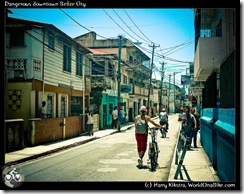 The streets in front of the shops are filled with young black males though, many of them either stoned or drunk (this is during day time) and most (!) of them trying to take my sunglasses, bicycle, money and whatever they could get their hands and eyes on. At least they did not use any violence, but simply ‘asked’ for it.
The streets in front of the shops are filled with young black males though, many of them either stoned or drunk (this is during day time) and most (!) of them trying to take my sunglasses, bicycle, money and whatever they could get their hands and eyes on. At least they did not use any violence, but simply ‘asked’ for it.
‘Hey man, lemme try those shades man’, while already reaching with both hands for my sunglasses which I was, well, wearing.
‘Gimme that bike man, it looks expensive my friend’, ‘Gimme some money man..’; ‘MMhheuuyww, yyeahh, hhmm?’ and similar Creole expressions.
Others tried to touch/grasp/take us and the few things we were carrying without saying much, which is just as annoying.
We were staying with a friendly CouchSurfing host named Jorge, a dermatologist, originally from Nicaragua. He took us to a nice area of town in the evening, but the moment we got our of our car, we were immediately approached and harassed by yet another ‘relaxed’ dude and apparently this was ‘normal’.
When walking back to his house the next night we felt not just annoyed, but threatened when two young guys on bicycles circled around us and then tried to block our way on the sidewalk without saying anything. Fortunately we were already in front of Jorge’s house by then, and could slip through his front gate without confronting them.
All in all, nothing bad actually happened, while we walked and cycled around town several times, so I guess you could say that it is a ‘safe’ city. But the general atmosphere is negative and threatening and too many young black males seem to live of ‘being relaxed’ and are trying to make easy money.
At least we did not encounter any violence as was reported in the local newspapers, where armed robberies, rapes and muggings were daily stories even in a small city like this (with only about 70,000 people living there). Maybe it was not me who was being racist, but the ‘homeless people themselves are’, as the great Chris Rock once pointed out in yet another inventive display of his inverted logic, ‘as somehow there are no Chinese or Gay homeless people’…
It was time to pick up my sister and nice from the airport as they were going to stay 2 weeks with us. Let’s see if the rest of the country would be friendlier than this seedy city.
Day 3 & 4: 14/15th July: Mile 333 – 301 – Galbraith lake
July 16, 2008 by Harry
Filed under Trip reports, Friendly people, North America, Alaska
14th July
Happy B-day Shaunie Shiny Shoes and PJW!
The first hour was flat but muddy, which made it hard going and slow. At least, there were not too many mosquitos while cycling, so we could leave the headnets off. Suddenly the hils were back in full force.
Dalton Highway Rule #8 for cyclists: if a hill has a name, it is mostly bad news as it will be very steep..
We were definitely nearing the Brooks Range now. The vague shapes we had seen in the distance were coming into focus and turned out to be nice mountains. The road meandered through but was already slowly going up as well. The road looked friendly, but the many remains of exploded tired reminded of what the Information booklet had told us: Read more
Day 2: Dalton Highway, mile 387 – 333, 13th July 2008
July 14, 2008 by Harry
Filed under Trip reports, North America, Alaska
People who know me, know that I am generally quite laid back. I hate a few things though: intolerance, dishonesty, general stupidity. And mosquitos. Especially mosquitos.
The wind was gone and the air was filled with a low but constant buzzing noise. Millions of mosquitos were hovering above the tundra. In Alaska the mosquitos are not just annoying, they are annoying in very large quantities and sizes. We were warned about them and fortunately Peter from Outdoordacht had supplied us with some Sea to Summit head nets. It might sound excessive, but unless you have experienced this, you have no idea how crazy these bugs can drive you.
We had our breakfast inside our tent and then packed quickly and headed off. We noticed that as long as you were cycling, it was still reasonably doable, but when stopping, even for a moment, the mozzies would attack. we almost wished for the wind to return, not sure yet, which of the two makes the cycling the hardest. Read more


